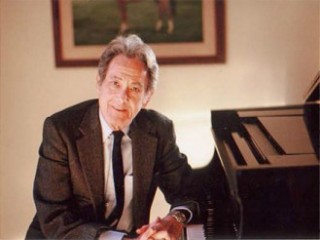
Joe Bushkin biography
Date of birth : 1916-11-07
Date of death : 2004-11-03
Birthplace : New York City, New York, U.S.
Nationality : American
Category : Famous Figures
Last modified : 2011-10-25
Credited as : jazz pianist, That Rat Race, Frank Sinatra
0 votes so far
The son of Al Bushkin and Ruth Hirsch, both Ukrainian immigrants, Bushkin grew up in a Jewish-Italian-Irish neighborhood in New York City. Encouraged by their father, a barber who played cello in between customers, both Bushkin and his brother, Arthur, developed musical talents. Arthur played violin, while the younger Bushkin demonstrated a knack for playing the piano at an early age. He began taking piano lessons with an upstairs neighbor at the age of ten, and then studied with his landlord's son. His father augmented the boys' musical education by taking them, on alternate weeks, to Sunday-morning concerts at New York's Capitol Theatre. Bushkin took piano lessons until the age of 13, when he injured his hand in a bicycle accident.
Bushkin attended P.S. 171 and, for a time, DeWitt Clinton High School, where he formed a band with classmates. He transferred to a trade school, where he demonstrated a talent for layout and poster design, but soon began playing Long Island club dates with Irving Goodman, a trumpeter and brother of clarinetist Benny Goodman. Bushkin nearly recorded with Irving Goodman---he was asked to fill in for Goodman's absent regular pianist, Teddy Wilson---but Wilson arrived just before the session began. Bushkin found his true calling when he encountered a jazz band in Harlem on a visit to a club with his father.
Bushkin landed his first regular gig in 1932, backing singer Frank LaMarr at the famed Roseland Ballroom in Brooklyn. He next joined saxophonist Paul Tremaine and His Band from Lonely Acres, playing regularly at a Chinese restaurant, then landed at the Prince George Hotel in Hoboken, New Jersey, playing from 9 p.m. to 5 a.m. for forty dollars a night. He was forced to quit, however, when his father discovered that the hotel was a bordello. In 1935 Bushkin became the intermission pianist at the Famous Door, playing between sets of trumpeter Bunny Berigan's band and occasionally joining Berigan on piano, trumpet or vocals. In 1936 he joined Berigan and clarinetist Artie Shaw at one of legendary singer Billie Holiday's earliest recording sessions. From 1936 to 1938 he backed guitarist Eddie Condon, formerly a member of Berigan's band. Bushkin rejoined Berigan briefly in 1938 and, after Berigan went bankrupt, performed with cornetist Muggsy Spanier, whom he joined on the 1939 classic recording "Relaxing at the Touro." While with Spanier he also played with Fats Waller, in a show where the two played back-to-back on their respective piano benches in a "battle of music."
Bushkin next became the intermission pianist at Kelly's Stable in New York, and he unsuccessfully auditioned for Benny Goodman's band. "I auditioned but I didn't get the job---Johnny Guarinieri did---and it broke my heart," he told the New Yorker. In January of 1940 he joined trumpeter Tommy Dorsey's band, which also featured singer Frank Sinatra. In 1941 Bushkin co-wrote the song "Oh! Look at Me Now," which became one of Sinatra's first hits. Bushkin joined the Army in 1942 during World War II, and played trumpet with various Army Air Force bands. He also directed the Moss Hart musical Winged Victory, which played for six months on Broadway. After the war he returned to New York, where he accepted studio work with NBC and studied with composer Stefan Wolpe. He briefly joined Benny Goodman's band in 1946, replacing pianist Mel Powell, but he told the New Yorker, "We didn't see eye to eye." For the next few years, he supported himself with a variety of work, including writing radio jingles and scoring and performing as a bandleader in the musical That Rat Race.
Bushkin released his first two solo albums, I Love a Piano (Atlantic) and Piano Moods (Columbia), in 1950. The following year he released After Hours on Columbia. That year he also began to play regularly at the newly opened Embers, which became a hot spot for jazz. His typical ensemble included trumpeter Buck Clayton, bassist Milt Hinton, and drummer Jo Jones. He joined Sinatra's band during its run at New York's Paramount Theatre in 1951, visited England for five months in 1953, and joined trumpeter Louis Armstrong's All-Stars upon his return. In 1955 Bushkin released Midnight Rhapsody on Capitol, and the title track became a minor hit. He continued to play the Manhattan nightclub circuit throughout the 1950s and 1960s. He moved to the West Coast and later to Hawaii, with his wife, Francice Oliver Netcher, and the two raised four daughters. He retired to Santa Barbara, California, in 1971, and began breeding thoroughbred horses. "I got tired of guys requesting 'Melancholy Baby' and throwing up on me," he told John S. Wilson of the New York Times. He came out of retirement in 1976 to join Bing Crosby on a cross-country tour, the singer's last.
He continued to play selected dates, mainly in New York, for the next two-and-a-half decades, and in 1984 he played the re-opening of the King Cole Room at the St. Regis-Sheraton Hotel, starting with a salute to Armstrong.
Bushkin died at his home in Santa Barbara following a bout of pneumonia on November 3, 2004, just four days before his 88th birthday.

















